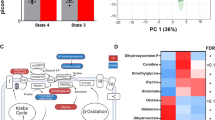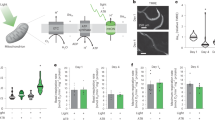Abstract
Arising from E.-Z. Shen et al. Nature 508, 128–132 (2014); doi:10.1038/nature1301210.1038/nature13012
Ageing and lifespan of organisms are determined by complicated interactions between their genetics and the environment, but the cellular mechanisms remain controversial; several studies suggest that cellular energy metabolism and free radical dynamics affect lifespan, implicating mitochondrial function. Recently, Shen et al.1 provided apparent mechanistic insight by reporting that mitochondrial oscillations of ‘free radical production’, called ‘mitoflashes’, in the pharynx of three-day old Caenorhabditis elegans correlated inversely with lifespan. The interpretation of mitoflashes as ‘bursts of superoxide radicals’ assumes that circularly permuted yellow fluorescent protein (cpYFP) is a reliable indicator of mitochondrial superoxide2, but this interpretation has been criticized because experiments and theoretical considerations both show that changes in cpYFP fluorescence are due to alterations in pH, not superoxide3,4,5,6,7. Here we show that purified cpYFP is completely unresponsive to superoxide, and that mitoflashes do not reflect superoxide generation or provide a link between mitochondrial free radical dynamics and lifespan. There is a Reply to this Brief Communication Arising by Cheng, H. et al. Nature 514, http://dx.doi.org/10.1038/nature13859 (2014).

Similar content being viewed by others
References
Shen, E.-Z. et al. Mitoflash frequency in early adulthood predicts lifespan in Caenorhabditis elegans. Nature 508, 128–132 (2014)
Wang, W. et al. Superoxide flashes in single mitochondria. Cell 134, 279–290 (2008)
Muller, F. L. A critical evaluation of cpYFP as a probe for superoxide. Free Radic. Biol. Med. 47, 1779–1780 (2009)
Ezeriņa, D., Morgan, B. & Dick, T. P. Imaging dynamic redox processes with genetically encoded probes. J. Mol. Cell. Cardiol. 73, 43–49 (2014)
Schwarzländer, M., Logan, D. C., Fricker, M. D. & Sweetlove, L. J. The circularly permuted yellow fluorescent protein cpYFP that has been used as a superoxide probe is highly responsive to pH but not superoxide in mitochondria: implications for the existence of superoxide ‘flashes’. Biochem. J. 437, 381–387 (2011)
Santo-Domingo, J., Giacomello, M., Poburko, D., Scorrano, L. & Demaurex, N. OPA1 promotes pH flashes that spread between contiguous mitochondria without matrix protein exchange. EMBO J. 32, 1927–1940 (2013)
Schwarzländer, M. et al. Mitochondrial ‘flashes’: a radical concept repHined. Trends Cell Biol. 22, 503–508 (2012)
Poburko, D., Santo-Domingo, J. & Demaurex, N. Dynamic regulation of the mitochondrial proton gradient during cytosolic calcium elevations. J. Biol. Chem. 286, 11672–11684 (2011)
Schwarzländer, M. et al. Pulsing of membrane potential in individual mitochondria: a stress-induced mechanism to regulate respiratory bioenergetics in Arabidopsis. Plant Cell 24, 1188–1201 (2012)
Azarias, G. & Chatton, J. Y. Selective ion changes during spontaneous mitochondrial transients in intact astrocytes. PLoS ONE 6, e28505 (2011)
Wei-LaPierre, L. et al. Respective contribution of mitochondrial superoxide and pH to mitochondria-targeted circularly permuted yellow fluorescent protein (mt-cpYFP) flash activity. J. Biol. Chem. 288, 10567–10577 (2013)
Pouvreau, S. Superoxide flashes in mouse skeletal muscle are produced by discrete arrays of active mitochondria operating coherently. PLoS ONE 5, e13035 (2010)
Zhang, X. et al. Superoxide constitutes a major signal of mitochondrial superoxide flash. Life Sci. 93, 178–186 (2013)
Quatresous, E., Legrand, C. & Pouvreau, S. Mitochondria-targeted cpYFP: pH or superoxide sensor? J. Gen. Physiol. 140, 567–570 (2012)
Ma, Q. et al. Superoxide flashes: early mitochondrial signals for oxidative stress-induced apoptosis. J. Biol. Chem. 286, 27573–27581 (2011)
Breckwoldt, M. O. et al. Multiparametric optical analysis of mitochondrial redox signals during neuronal physiology and pathology in vivo. Nature Med. 20, 555–560 (2014)
Hou, T., Wang, X., Ma, Q. & Cheng, H. Mitochondrial flashes: new insights into mitochondrial ROS signaling and beyond. J. Physiol. (Lond.) 592, 3703–3713 (2014)
Author information
Authors and Affiliations
Contributions
M.S., A.J.M., T.P.D. and M.P.M. conceived the project. M.S., S.W., Y.G.E. and V.V.B. performed spectroscopic experiments. S.W. and T.P.D. performed modelling of protein structures. All authors contributed to experimental design, discussed the results, and wrote the manuscript.
Corresponding author
Ethics declarations
Competing interests
Competing Financial Interests Declared none.
PowerPoint slides
Rights and permissions
About this article
Cite this article
Schwarzländer, M., Wagner, S., Ermakova, Y. et al. The ‘mitoflash’ probe cpYFP does not respond to superoxide. Nature 514, E12–E14 (2014). https://doi.org/10.1038/nature13858
Received:
Accepted:
Published:
Issue Date:
DOI: https://doi.org/10.1038/nature13858
- Springer Nature Limited
This article is cited by
-
Identity, structure, and function of the mitochondrial permeability transition pore: controversies, consensus, recent advances, and future directions
Cell Death & Differentiation (2023)
-
Lighting the light reactions of photosynthesis by means of redox-responsive genetically encoded biosensors for photosynthetic intermediates
Photochemical & Photobiological Sciences (2023)
-
Arabidopsis guard cell chloroplasts import cytosolic ATP for starch turnover and stomatal opening
Nature Communications (2022)
-
Dynamic single-cell NAD(P)H measurement reveals oscillatory metabolism throughout the E. coli cell division cycle
Scientific Reports (2018)
-
Absence of physiological Ca2+ transients is an initial trigger for mitochondrial dysfunction in skeletal muscle following denervation
Skeletal Muscle (2017)





